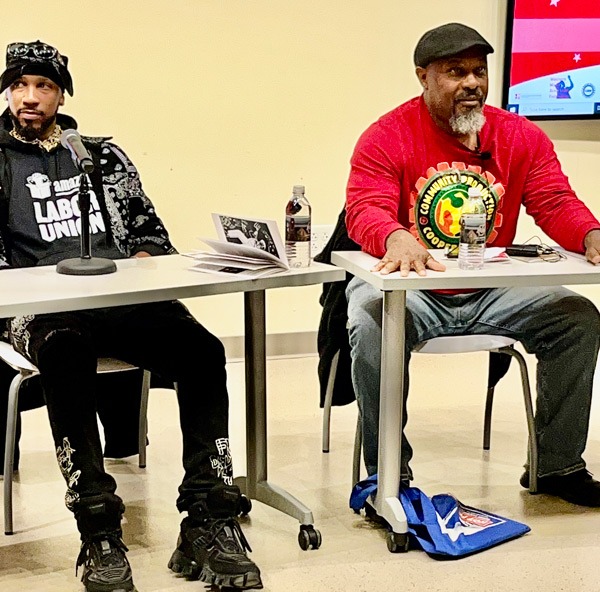

The gathering was titled Building Worker Power through Solidarity, Cooperation and Care. Organized by the Labor Center at the University of Massachusetts Amherst and Wellspring Cooperative, a worker co-op network based in nearby Springfield, the conference set to develop deeper ties between unions and worker co-ops—and to advance organizing for a solidarity economy.
Kicking off the event were two prominent movement actors—Kali Akuno, cofounder of Jackson, Mississippi-based Cooperation Jackson; and Chris Smalls, president of the Amazon Labor Union, the first union to ever win an election at a US-based Amazon facility. With an estimated 8,300 workers, it was also the largest single US private-sector union election victory in 33 years.
The two speakers came from very different backgrounds. Akuno is a long-time Black nationalist movement veteran who has spent the last decade organizing in Jackson, Mississippi, with a focus on building people’s assemblies to foster small “d” democracy, an independent Black political party, and a broad solidarity economy rooted in cooperatives and community land ownership. Akuno detailed this approach in a document written for the Malcolm X Grassroots Movement and the New Afrikan People’s Organization known as the Jackson-Kush Plan. Smalls, by contrast, is very new to organizing. By his own description, it was only when he was fired by Amazon in March 2020 after spending the previous four-and-a-half years as a warehouse supervisor that he became “radicalized.”
The conversation revealed two distinctive outlooks on the state of organizing, but Akuno and Smalls also underscored some common challenges for movements today.

Organizing in Jackson
The road to organizing in Jackson was a long one. Akuno explained that 20 years ago, he was working in Oakland, California. As he detailed, “I was in the process of organizing a school.” It was a smaller autonomous school called the School of Social Justice and Community Development. But at a certain point, Akuno realized that his education work was not effectively challenging relationships of power.
As Akuno put it,
I am bringing in 110 kids. I am promising [them] to go to college. And I have no understanding if there will be a job on the other end. And why am I preparing them for a job anyway? And if that’s not it, what should I be doing? I am an educator. What is the future? At the end of the year, nobody is going to save us. But what does that practically translate into?
Ultimately, this self-questioning convinced Akuno that changing ownership of the economy was critical to liberation; that there had to be a pivot in strategy toward cooperatives and toward the construction of a solidarity economy. Additionally, Hurricane Katrina, which flooded New Orleans in 2005, helped persuade him and colleagues in the Malcolm X Grassroots Movement that the center of organizing had to be in the South, helping to precipitate the focus on Jackson. The city, more than 80 percent African American and the state capital of Mississippi, seemed to be fertile ground for organizing. As Akuno put it, “We figured out we could win the [municipal] election and rearticulate the local level to open space to do cooperative development.”
Organizing was highly successful. A candidate supported by Akuno and his colleagues, Chokwe Lumumba, was elected mayor of Jackson in 2013. The following year, Cooperation Jackson was formed. However, eight months after Lumumba was elected, he died of heart failure, and the anticipated alliance with the city government did not materialize. Ultimately, Lumumba’s son, Chokwe Antar Lumumba, after initially falling short, was elected mayor in 2017 (and reelected in 2021). But, even so, the city government and the social movement represented by Cooperation Jackson and its allies have not always seen eye to eye.
“I don’t have to convince people they are oppressed . . . I have to convince people we can do something about it.”
Akuno emphasized that the central foundation of Cooperation Jackson’s work is not the worker cooperatives it helps develop per se, but rather the community land trust, because the latter ensures Cooperation Jackson’s ownership of land. Land ownership, Akuno pointed out, facilitates two important things. First, it is critical to be able to “articulate a program around food sovereignty,” including the development of community farms. This helps advance community food self-sufficiency, the lack of which had been so harmful to residents of New Orleans after Hurricane Katrina. Second, as Akuno pointed out, owning land and facilities gives Cooperation Jackson “an opportunity to experiment over a period of time to figure out what would make best for us” without having to pay rent to anyone.
In terms of organizing strategy, Akuno noted that, in one sense, organizing in Mississippi is easy. “I don’t have to convince people they are oppressed,” he noted. What is more challenging, however, is overcoming alienation. As Akuno explained, “I have to convince people we can do something about it. Is your solution going to work? Is it viable?”
Organizing Amazon: Details That Matter
At Amazon, union organizer Chris Smalls faced a similar challenge of persuading people in the Staten Island warehouse he was helping to organize that change was truly possible. Smalls estimates the size of that facility to be one million square feet, the size of 17 football fields. Union drives at Amazon have not been rare. But what had not occurred in the United States, until Smalls and his colleagues won their union election in 2022, were successful union drives. “Amazon has been around for 29 years. [Unions] have tried. Even in my building, three years before. I never heard about it. They didn’t get anywhere,” Smalls noted.
Sign up for our free newsletters
Subscribe to NPQ's newsletters to have our top stories delivered directly to your inbox.
By signing up, you agree to our privacy policy and terms of use, and to receive messages from NPQ and our partners.
Working conditions did not provide much space for organizing. Many workers, including himself, Smalls pointed out, faced commutes of greater than two hours each way. “They commute and then work 10 hours and then do that again. I was working 12 hours. Come home, take a nap, rinse, and repeat,” Smalls related. Workers, in short, are exhausted.
“What we did was build a culture that was a safe haven for these workers.”
On top of that, there was company opposition to overcome. Company management, Smalls said, “plastered the buildings with anti-union propaganda. They pay union busters anywhere from $3,200 to $10,000 a day.” Smalls estimated that in six months at the Staten Island warehouse, Amazon held three thousand captive audience meetings—that is, meetings at which groups of workers, while on the job, were forced to watch anti-union propaganda.
Countering all this, Smalls said, “took something unprecedented, untraditional.” The fact that Amazon Labor Union was an independent union, rather than a local of a larger union, helped, he argued. “Representation is important. Brand new: putting workers in the driver’s seat. And creativity. That’s what it took to beat Amazon.”
Smalls also emphasized what he called “details that matter” as being a central principle in the union’s organizing. This, he noted, meant meeting workers “where they are at. Not just one conversation—many conversations. That day management got on their ass—we were there. Accountability is availability. We had to educate them. Earn their trust.”
In addition to talking with workers, attention to details that matter included hosting barbeques, as well as helping with phone bills and Uber rides. Personal steps like these, Smalls said, “showed the workers that we cared and that our love and solidarity was real.” Critically, Smalls added, “what we did was build a culture that was a safe haven for these workers.”
Where Do Movements Go from Here?
The organizing of the 8,300-worker Staten Island warehouse is a historic achievement. Yet it is also only a first step. The workers do not yet have a collective bargaining agreement, and indeed Amazon is engaged in classic stonewalling tactics to delay that as long as possible. (Famously, Starbucks, which has seen nearly 300 locations unionized, has employed similar stalling tactics.) Meanwhile, the number of Amazon warehouses that have been unionized remains one. This is why, for example, Smalls recently visited an Amazon hub in Kentucky and met with an organizing committee there. We must organize “building by building,” Smalls emphasized.
“We can build our own systems and we have to.”
How do you balance the need to keep the energy up at the Staten Island facility, even as time and resources are employed to help organize union locals elsewhere? It is not easy. Smalls was dismissive of a New York Times article published last March that detailed divisions within the Amazon Labor Union. Nonetheless, divisions do exist among the workers between those who would counsel a greater focus on building the union at the Staten Island facility and those, like Smalls, who place more emphasis on extending the union beyond the Staten Island warehouse.
Smalls recognizes the long road ahead, “We are very far behind. We are in the infancy stage. It is day one,” he noted. Still, he retained a sense of optimism. “We kicked down the door.”
Akuno also offered his own take on the state of the movement: solidarity economy organizing has progressed far beyond its infancy, but there remains a lot of organizing to do. “We need to be the champions of democracy, but that doesn’t mean perpetuating the systems that exist. We can build our own systems and we have to.” Akuno added that the definition of democracy needed to change: “The notion that democracy and capitalism go hand in hand, that’s always been an illusion.”
Many forget “how beautiful” the racial justice uprising of 2020 was, Akuno recalled. “A lot of it was spontaneous. If we could have sustained it, it would be different.” But achieving that sustained push would have required not just resources, but education and political direction.
The state of solidarity economy organizing is far more developed than it has been in decades. “There is more organizing now than at any time in my lifetime. It is just small and fractured,” Akuno observed. To get beyond that requires transcending “the neoliberal style of organizing that we have grown accustomed to,” by which he meant favoring individual organization campaigns over broader movement building.
Akuno sees his primary task as an organizer these days as helping “connect more people” to build on the organizing groundwork that has already been laid and to seek, not so much unity, but at least a common agreed-upon direction. He challenged audience members to consider: “What are the points that we can work in solidarity on without surrendering autonomy to wield collective power?” For social movements to advance today, Akuno emphasized, this is the kind of “shift we have to make in our orientation.”












